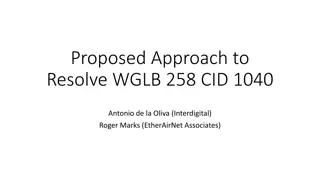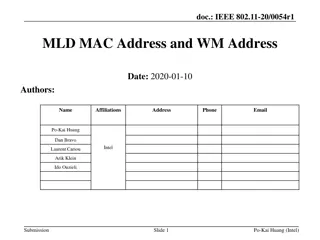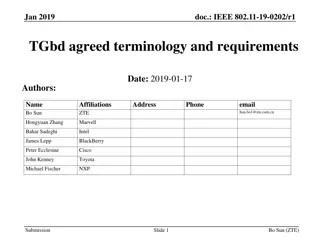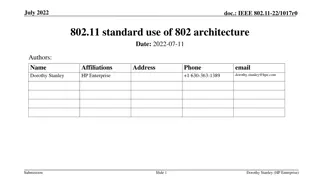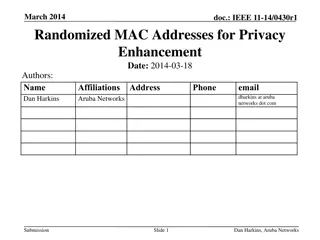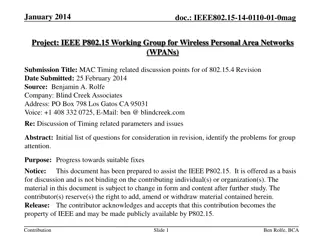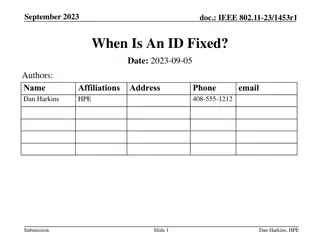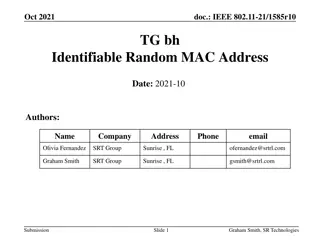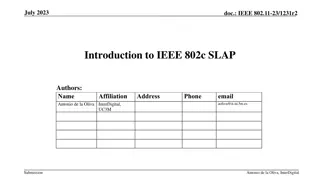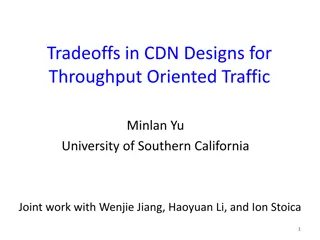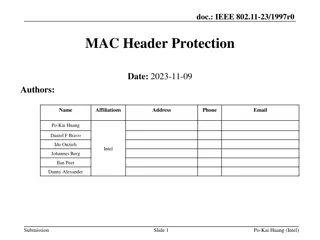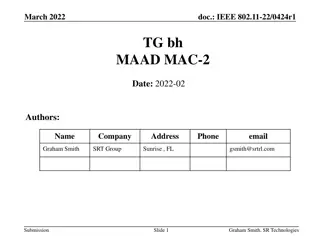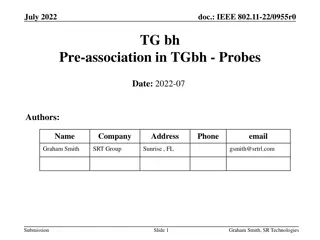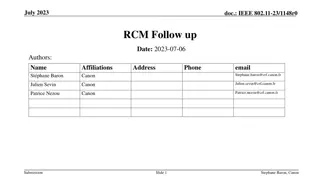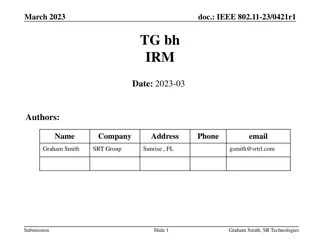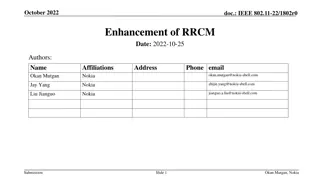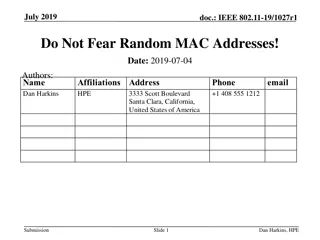IEEE 802.11-15/0376r2 UL-MU MAC Throughput Analysis
This document delves into the evaluation of UL-MU techniques to enhance MAC efficiency in IEEE 802.11 networks, focusing on the impact of non-full buffer traffic. It discusses the advantages and disadvantages of AP-initiated and STA-initiated UL-MU protocols, providing insights into adjusting transmission timing and handling TX demand responses. Consideration is given to various UL-MU protocol types, including AP-initiated and STA-initiated sequences. Additionally, the protocol A1 for AP-initiated UL-MU is examined in terms of CSI knowledge and TX demand handling for connected STAs.
Download Presentation

Please find below an Image/Link to download the presentation.
The content on the website is provided AS IS for your information and personal use only. It may not be sold, licensed, or shared on other websites without obtaining consent from the author.If you encounter any issues during the download, it is possible that the publisher has removed the file from their server.
You are allowed to download the files provided on this website for personal or commercial use, subject to the condition that they are used lawfully. All files are the property of their respective owners.
The content on the website is provided AS IS for your information and personal use only. It may not be sold, licensed, or shared on other websites without obtaining consent from the author.
E N D
Presentation Transcript
March 2015 doc.: IEEE 802.11-15/0376r2 UL-MU MAC Throughput under Non-Full Buffer Traffic Date: 2015-03-10 Authors: Name Affiliations Address Phone Email Tatsumi Uwai Radrix co.ltd +81-948-29-7937 uwai@radrix.com 820-8502 Incubation Facilities, Kawazu 680-4, Iizuka City, Fukuoka Japan Yuhei Nagao nagao@radrix.com Tran Thi Thao Nguyen Kyushu Institute of Technology nguyen@dsp.cse.kyutech.ac.jp Leonardo Lanante leonardo@cse.kyutech.ac.jp Hiroshi Ochi ochi@cse.kyutech.ac.jp Submission Slide 1 Tatsumi Uwai, Radrix co. ltd
March 2015 doc.: IEEE 802.11-15/0376r2 Abstract UL-MU is considered as a technique to increase the efficiency which meets the requirement in 802.11ax. In previous contributions, the need for a low overhead UL- MU protocol was discussed [1] [2]. Another discussion is to decide who and when to initiate UL- MU protocol [1] [2] [3]. AP initiated STA initiated [1] 11-15/0064r1 [2] 11-14/0598r0 [3] 11-15/0091r0 Submission Slide 2 Tatsumi Uwai, Radrix co. ltd
March 2015 doc.: IEEE 802.11-15/0376r2 Consideration on UL-MU In previous contributions, full buffer traffic was assumed where STAs always have UL frame to send. In this presentation, we evaluate the effect of non-full buffer traffic in the MAC efficiency of several protocol types. Submission Slide 3 Tatsumi Uwai, Radrix co. ltd
March 2015 doc.: IEEE 802.11-15/0376r2 UL-MU protocol AP Initiated Advantage: Possibility to adjust UL-MU transmission timing depending on all STAs TX demand [1]. Disadvantage: Possibility of no transmission after initiating UL-MU transmission. STA Initiated Advantage: STAs can initiate UL-MU sequence without waiting AP initiation. It means at least one UL frame can be transmitted. Disadvantage: cannot adjust UL-MU transmission timing depending on all STAs TX demand. Submission Slide 4 Tatsumi Uwai, Radrix co. ltd
March 2015 doc.: IEEE 802.11-15/0376r2 UL-MU Protocol list We consider several protocol types as following, AP initiated STA initiated Comment TX demand response is transmitted to AP as SU (1). A1 (3). S1 TX demand response is transmitted to AP as MU (2). A2 (4). S2 No TX demand response to any STA (5). S3 Submission Slide 5 Tatsumi Uwai, Radrix co. ltd
March 2015 doc.: IEEE 802.11-15/0376r2 AP Initiated UL-MU protocol Protocol A1 [1] Advantage AP has knowledge of complete CSI and TX demand for all STAs. Disadvantage Overhead to find out STAs TX demand is large. AP needs to balance UL MU cycle time for high throughput and low latency. Multicast AP Inquiry Inquiry Inquiry Sched. ACK Inquiry STA 1 Resp. UL MU frame Resp. STA 2 Resp. UL MU frame : : STA N Resp. UL MU frame Time UL MU cycle time Submission Slide 6 Tatsumi Uwai, Radrix co. ltd
March 2015 doc.: IEEE 802.11-15/0376r2 AP Initiated UL-MU protocol cont. Protocol A2 [3] Advantage Overhead is small Disadvantage AP cannot obtain complete CSI from response frames resulting in suboptimum scheduling. AP needs to balance UL MU cycle time for high throughput and low latency. AP Inquiry Sched. ACK Inquiry STA 1 Resp. UL MU frame Resp. STA 2 Resp. UL MU frame Resp. : : STA N Resp. UL MU frame Resp. Time UL MU cycle time Submission Slide 7 Tatsumi Uwai, Radrix co. ltd
March 2015 doc.: IEEE 802.11-15/0376r2 STA Initiated UL-MU protocol Protocol S1 Advantage AP has knowledge of complete CSI and TX demand for all STAs. Disadvantage Overhead become large to find out STAs TX demand. AP Inquiry Inquiry Sched. ACK STA 1 Req. UL MU frame STA 2 : : STA N Resp. UL MU frame Resp. UL MU frame Time Overhead Submission Slide 8 Tatsumi Uwai, Radrix co. ltd
March 2015 doc.: IEEE 802.11-15/0376r2 STA Initiated UL-MU protocol cont. Protocol S2 Advantage Overhead is small Disadvantage AP cannot obtain complete CSI from response frames resulting in suboptimum scheduling. Inquiry AP Sched. ACK STA 1 Req. Resp. UL MU frame STA 2 : : Resp. UL MU frame STA N Resp. UL MU frame Time Overhead Submission Slide 9 Tatsumi Uwai, Radrix co. ltd
March 2015 doc.: IEEE 802.11-15/0376r2 STA Initiated UL-MU protocol cont. Protocol S3 [2] Advantage Overhead is comparable with UL legacy RTS/CTS access mechanism. Disadvantage Scheduling is only based on long term statistics. AP Inquiry ACK STA 1 Req. UL MU frame STA 2 : : UL MU frame STA N UL MU frame Time Overhead Submission Slide 10 Tatsumi Uwai, Radrix co. ltd
March 2015 doc.: IEEE 802.11-15/0376r2 Evaluation Condition N : Number of STAs multiplexed = 1 4 STAs 80 MHz bandwidth, 1SS, MCS 8 Resource is equally distributed to all transmitting STAs The Subcarrier design is the same as in 11ac. Assumes OFDMA using short GI for UL-MU transmission TXOP limit = 0 Block ACK Error free Non-full buffer traffic model Video Conferencing Traffic Model [4] Only the uplink traffic is considered. ?? ????? ????[???] ??? ? ???? ??? ???? = ????? ???????????? ????[??] MU frame size : Total number of bit sent by all STAs Submission Slide 11 Tatsumi Uwai, Radrix co. ltd
March 2015 doc.: IEEE 802.11-15/0376r2 Evaluation Result : MAC Throughput with Min cycle time with Min cycle time Min cycle time is same with protocol duration. S3 has best performance regardless of offered load. S1 and S2 has better performance compared to A1 and A2 with min cycle time at lower offered load. The difference becomes smaller and smaller as offered load increases. Submission Slide 12 Tatsumi Uwai, Radrix co. ltd
March 2015 doc.: IEEE 802.11-15/0376r2 Evaluation Result : MAC Throughput with Max cycle time with Max cycle time Max cycle time is the longest possible UL-MU cycle time such that the STAs buffer contents doesn t increase infinity. A1 and A2 with max cycle time has better performance than all STA initiated protocols. However, latency for both is very high. Submission Slide 13 Tatsumi Uwai, Radrix co. ltd
March 2015 doc.: IEEE 802.11-15/0376r2 Summary From this result, Both AP and STA initiated UL-MU protocol have advantages. AP initiated UL-MU protocol (protocol A1, A2) can have the best throughput by controlling UL-MU transmission timing depending on all STAs TX demand at the expense of latency. STA initiated UL-MU protocol has the best performance in terms of latency, and also good throughput without other STA coordination. Submission Slide 14 Tatsumi Uwai, Radrix co. ltd
March 2015 doc.: IEEE 802.11-15/0376r2 Straw Poll #1 Do you agree to add to the TGax Specification Framework: x.y.z The amendment shall define a mechanism for both AP and non-AP STA to initiate a UL MU transmission. Y N A Submission Slide 15 Tatsumi Uwai, Radrix co. ltd
March 2015 doc.: IEEE 802.11-15/0376r2 Reference [1]Tomoko Adachi, Hiroki Mori, Brian Hart, Sean Coffey, Sigurd Schelstraete, Yuichi Morioka, Guido Hiertz, Consideration on UL-MU overheads , 11- 15/0064r1, Toshiba Corporation, Toshiba Corporation, Cisco Systems, Realtek, Quantenna , Sony, Ericsson [2] Tran Thi Thao Nguyen, Leonardo Lanante, Hiroshi Ochi, Tatsumi Uwai, Yuhel Nagao, Uplink multi-user MAC protocol for 11ax , 11-14/0598r0, Kyushu Institute of Technology, Radrix co. ltd [3] Woojin Ahn, Jinsoo Ahn, Ronny Yonho Kim, UL-OFDMA procedure in IEEE 802.11ax , 11-15/0091r0, Yonsei Univ., KNUT [4] 11ax Evaluation Methodology, 11-14-0571-07-00ax-evaluation- methodology.docx Submission Slide 16 Tatsumi Uwai, Radrix co. ltd
March 2015 doc.: IEEE 802.11-15/0376r2 Appendix Submission Slide 17 Tatsumi Uwai, Radrix co. ltd
March 2015 doc.: IEEE 802.11-15/0376r2 Evaluation Result : Latency Min cycle time is same with protocol duration. Max cycle time is the longest possible UL-MU cycle time such that the STAs buffer contents doesn t increase infinity. Latency become large When protocol A1 and A2 use Max cycle time, latency can become as large as 80ms. Submission Slide 18 Tatsumi Uwai, Radrix co. ltd


